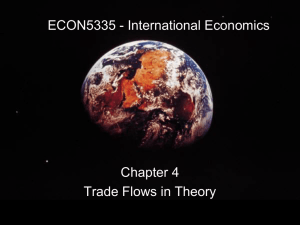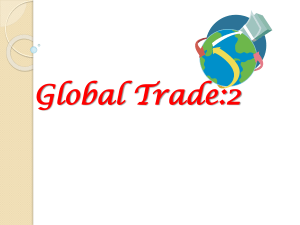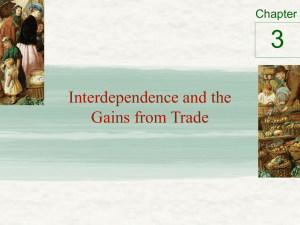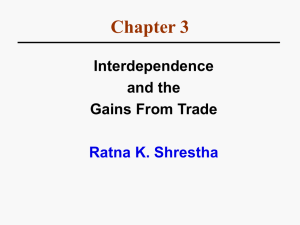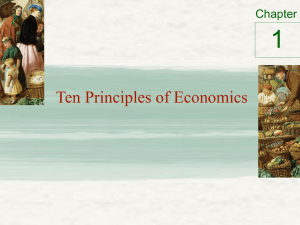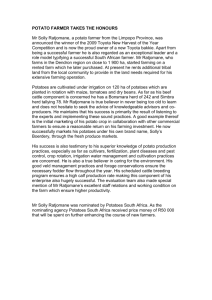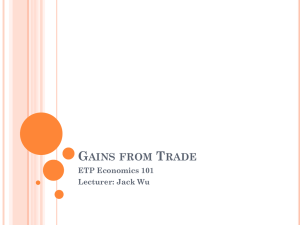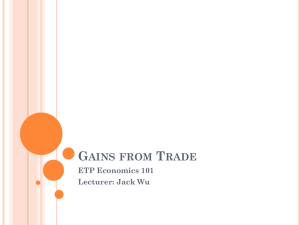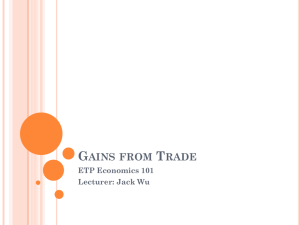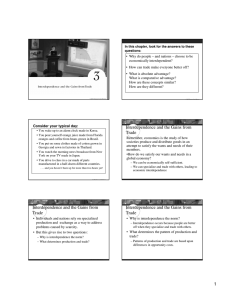Economic Thinking
advertisement
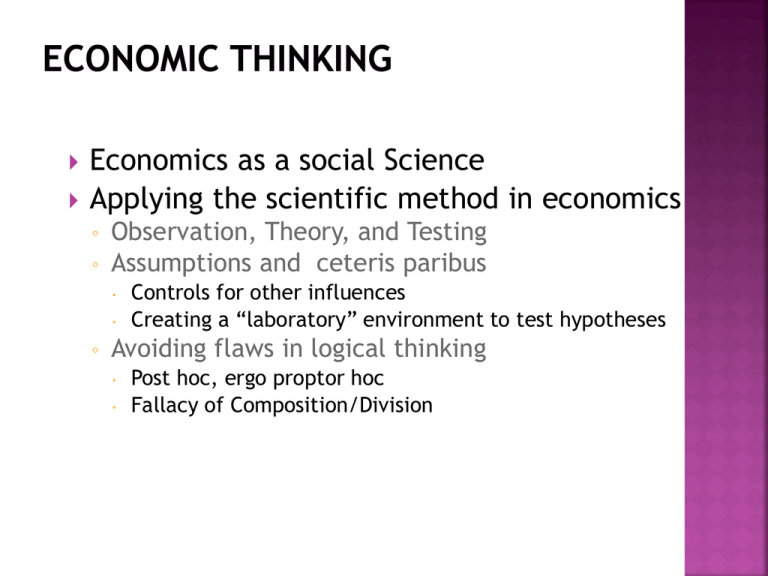
Economics as a social Science Applying the scientific method in economics ◦ ◦ Observation, Theory, and Testing Assumptions and ceteris paribus ◦ Controls for other influences Creating a “laboratory” environment to test hypotheses Avoiding flaws in logical thinking Post hoc, ergo proptor hoc Fallacy of Composition/Division The art of making models = making them simple and effective Spreadsheet and handouts Example: Production Possibilities Frontier (PPF) -efficiency, tradeoffs, opportunity costs, law of increasing costs, economic growth. Example: Circular Flow Model– what, how and for whom questions. ◦ overall economy, role of economic agents, output and income, product and factor markets What? - determined by consumer preferences and dollar “votes” How? – competition requires firms to produce at lowest possible costs “compete or be obsolete” For Whom? – it depends on ownership of resources and the prices that resources bring Efficiency versus equity revisited Voluntary versus involuntary exchange An intuitive approach to gains in trade Using an economic model to demonstrate the gains from trade All parties to a voluntary exchange must be made better off. Trade is mutually beneficial. Allows for specialization and division of labor and reduces opportunity costs. Increases interdependence Promotes cooperation rather than conflict Excerpt from Wealth of Nations (Fordham University website) Self-sufficiency Pros: independence Cons: loss of efficiency, variety in consumption and production Trade with Yakima? Trade with other states? Trade with other nations? Good model building: prove the point and make it simple Assumptions = things held true during the analysis = simplification Assumptions can be changed later to explore their implications Assumptions: Two individuals – rancher and a farmer Two goods – meat and potatoes Each work eight hours a day Farmer takes 60min/oz meat and 15min/oz potatoes Rancher takes 20min/oz of meat and 10min/oz of potatoes Absolute advantage ◦ Comparative advantage ◦ The rancher is more efficient than the farmer at producing both meat and potatoes The farmer is comparatively better at producing potatoes than the rancher. Comparative advantage and opportunity cost The person with the lower opportunity cost has a comparative advantage ◦ Someone always has a comparative advantage in the production of a least one thing ◦ How much can be produced? Need to know: Total time divided by time/output = total output, or output/time multiplied by total time = total output Farmer (8 hours = 480/min)/ (60 min/oz of meat) = 8 oz of meat Rancher (480min/20min/oz of meat)=24 oz of meat Copyright © 2004 South-Western (a) The Farmer ’s Production Possibilities Frontier Meat (ounces) If there is no trade, the farmer chooses this production and consumption. 8 4 0 A 16 32 Potatoes (ounces) Copyright©2003 Southwestern/Thomson Learning (b) The Rancher ’s Production Possibilities Frontier Meat (ounces) 24 If there is no trade, the rancher chooses this production and consumption. 12 0 B 24 48 Potatoes (ounces) Copyright©2003 Southwestern/Thomson Learning In math, slope = Δy/Δx but in this case meat is on the y-axis and potatoes are on the x-axis, so it become ΔM/ΔP E.g. Rancher ΔM/ΔP = -24/48 =-1/2 , but it is help to think of this as -1/2/1. Why? +1P → -½ M E.g. Farmer ΔM/ΔP =- 8/32 =-1/4 , but it is help to think of this as 1/4/1. Why? +1P → -1/4 M To get 1 P the rancher gives up 1/2M and the farmer gives up 1/4M Slope = opportunity cost (an example of making math meaningful to real world situations) Reverse directions ◦ ◦ Rancher to get 1M → -2P Farmer to get 1M → -4P Conclusions: Rancher has a comparative advantage in producing meat (1M costs 2P or 1P costs 1/2M) ◦ Farmer has a comparative advantage in producing potatoes (1P costs 1/4M or 1M costs 4P) ◦ The rancher should specialize in producing meat and the farmer should specialization in producing potatoes. Marginal versus Complete Approach Marginal adjustment Farmer -1M → +4P Rancher +1M → -2P Total 0M +2P, or Rancher -1P → +1/2M Farmer +1P → -1/4M Total 0P +1/4M Either way specializing and trading means either more meat or potatoes Mankiw explains gains a bit differently and perhaps in a more complicated way Farmer only produces potatoes and rancher produces a combination of meat and potatoes Trade takes place with equal amounts for each New totals lie outside the old PPF and represents a point on a consumption possibilities frontier Let’s see how he does it…. Copyright © 2004 South-Western (b) The Rancher’s Production and Consumption Meat (ounces) Rancher's production with trade 24 Rancher's consumption with trade 18 13 B* B 12 0 12 24 27 Rancher's production and consumption without trade 48 Potatoes (ounces) Copyright © 2004 South-Western (a) The Farmer’s Production and Consumption Meat (ounces) 8 Farmer's consumption with trade A* 5 4 Farmer's production and consumption without trade A Farmer's production with trade 0 32 16 Potatoes (ounces) 17 Copyright©2003 Southwestern/Thomson Learning The gains to each party are determined by the Terms of Trade ◦ The terms of trade must fall between the two parties opportunity costs (see spreadsheet) Positive analysis = gains exist so efficiency improvements can occur Normative analysis = who should get the gains Normative analysis involves value judgments and therefore must be made by others We will develop a model that measures the gains to trade to consumers and producers later History of Trade Tribal to feudal to modern times Adam Smith (1776) and David Ricardo (1817) Protectionism The costs of not trading (e.g. Cost of Protectionism) Distributional impacts – transfers from consumers to producers/workers Political preference for protection – the marginal costs to each consumer are small the marginal benefits to producers/workers are large We will develop models to show the above later Strategic trade can be a tool to develop certain industries China manipulates its exchange rate to generate artificial terms of trade The U.S. gets inexpensive products and the Chinese grow certain industries However, China finances its trade surplus by lending to the U.S and/or acquiring dollars or U.S. assets.

